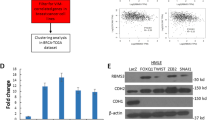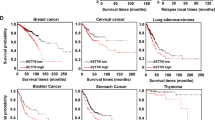Abstract
Tumor metastasis is the leading cause of death among breast cancer patients. PELP1 (proline, glutamic acid and leucine rich protein 1) is a nuclear receptor coregulator that is upregulated during breast cancer progression to metastasis and is an independent prognostic predictor of shorter survival of breast cancer patients. Here, we show that PELP1 modulates expression of metastasis-influencing microRNAs (miRs) to promote cancer metastasis. Whole genome miR array analysis using PELP1-overexpressing and PELP1-underexpressing model cells revealed that miR-200 and miR-141 levels inversely correlated with PELP1 expression. Consistent with this, PELP1 knockdown resulted in lower expression of miR-200a target genes ZEB1 and ZEB2. PELP1 knockdown significantly reduced tumor growth and metastasis compared with parental cells in an orthotopic xenograft tumor model. Furthermore, re-introduction of miR-200a and miR-141 mimetics into PELP1-overexpressing cells reversed PELP1 target gene expression, decreased PELP1-driven migration/invasion in vitro and significantly reduced in vivo metastatic potential in a preclinical model of experimental metastasis. Our results demonstrated that PELP1 binds to miR-200a and miR-141 promoters and regulates their expression by recruiting chromatin modifier histone deacetylase 2 (HDAC2) as revealed by chromatin immunoprecipitation, small interfering RNA and HDAC inhibitor assays. Taken together, our results suggest that PELP1 regulates tumor metastasis by controlling the expression and functions of the tumor metastasis suppressors miR-200a and miR-141.
This is a preview of subscription content, access via your institution
Access options
Subscribe to this journal
Receive 50 print issues and online access
$259.00 per year
only $5.18 per issue
Buy this article
- Purchase on Springer Link
- Instant access to full article PDF
Prices may be subject to local taxes which are calculated during checkout





Similar content being viewed by others
References
Eckhardt BL, Francis PA, Parker BS, Anderson RL . Strategies for the discovery and development of therapies for metastatic breast cancer. Nat Rev Drug Discov 2012; 11: 479–497.
Steeg PS . Tumor metastasis: mechanistic insights and clinical challenges. Nat Med 2006; 12: 895–904.
Stetler-Stevenson WG, Liotta LA, Kleiner DE Jr . Extracellular matrix 6: role of matrix metalloproteinases in tumor invasion and metastasis. FASEB J 1993; 7: 1434–1441.
Iorio MV, Ferracin M, Liu CG, Veronese A, Spizzo R, Sabbioni S et al. MicroRNA gene expression deregulation in human breast cancer. Cancer Res 2005; 65: 7065–7070.
Khoshnaw SM, Green AR, Powe DG, Ellis IO . MicroRNA involvement in the pathogenesis and management of breast cancer. J Clin Pathol 2009; 62: 422–428.
Wang L, Wang J . MicroRNA-mediated breast cancer metastasis: from primary site to distant organs. Oncogene 2012; 31: 2499–2511.
Hurst DR, Edmonds MD, Welch DR . Metastamir: the field of metastasis-regulatory microRNA is spreading. Cancer Res 2009; 69: 7495–7498.
Shi M, Liu D, Duan H, Shen B, Guo N . Metastasis-related miRNAs, active players in breast cancer invasion, and metastasis. Cancer Metastasis Rev 2010; 29: 785–799.
Saha RS, Vadlamudi RK . Role of estrogen receptor signaling in breast cancer metastasis. Int J Breast Cancer 2012; 2012: 654698.
O'Malley BW . Molecular biology. Little molecules with big goals. Science 2006; 313: 1749–1750.
Rosenfeld MG, Lunyak VV, Glass CK . Sensors and signals: a coactivator/corepressor/epigenetic code for integrating signal-dependent programs of transcriptional response. Genes Dev 2006; 20: 1405–1428.
Schiff R, Massarweh SA, Shou J, Bharwani L, Arpino G, Rimawi M et al. Advanced concepts in estrogen receptor biology and breast cancer endocrine resistance: implicated role of growth factor signaling and estrogen receptor coregulators. Cancer Chemother Pharmacol 2005; 56 (Suppl 1): 10–20 10-20.
Mann M, Krishnan S, Vadlamudi RK . Emerging significance of estrogen cancer coregulator signaling in breast cancer. Minerva Ginecol 2012; 64: 75–88.
O'Malley BW . Coregulators: from whence came these “master genes”. Mol Endocrinol 2007; 21: 1009–1013.
Vadlamudi RK, Kumar R . Functional and biological properties of the nuclear receptor coregulator PELP1/MNAR. Nucl Recept Signal 2007; 5: e004.
Chakravarty D, Tekmal RR, Vadlamudi RK . PELP1: A novel therapeutic target for hormonal cancers. IUBMB Life 2010; 62: 162–169.
Rajhans R, Nair S, Holden AH, Kumar R, Tekmal RR, Vadlamudi RK . Oncogenic potential of the nuclear receptor coregulator proline-, glutamic acid-, leucine-rich protein 1/modulator of the nongenomic actions of the estrogen receptor. Cancer Res 2007; 67: 5505–5512.
Roy S, Chakravarty D, Cortez V, De MK, Bandyopadhyay A, Ahn JM et al. Significance of PELP1 in ER-negative breast cancer metastasis. Mol Cancer Res 2012; 10: 25–33.
Gregory PA, Bert AG, Paterson EL, Barry SC, Tsykin A, Farshid G et al. The miR-200 family and miR-205 regulate epithelial to mesenchymal transition by targeting ZEB1 and SIP1. Nat Cell Biol 2008; 10: 593–601.
Nair BC, Nair SS, Chakravarty D, Challa R, Manavathi B, Yew PR et al. Cyclin-dependent kinase-mediated phosphorylation plays a critical role in the oncogenic functions of PELP1. Cancer Res 2010; 70: 7166–7175.
Chakravarty D, Roy SS, Babu CR, Dandamudi R, Curiel TJ, Vivas-Mejia P et al. Therapeutic targeting of PELP1 prevents ovarian cancer growth and metastasis. Clin Cancer Res 2011; 17: 2250–2259.
Bracken CP, Gregory PA, Kolesnikoff N, Bert AG, Wang J, Shannon MF et al. A double-negative feedback loop between ZEB1-SIP1 and the microRNA-200 family regulates epithelial-mesenchymal transition. Cancer Res 2008; 68: 7846–7854.
Yang Y, Ahn YH, Gibbons DL, Zang Y, Lin W, Thilaganathan N et al. The Notch ligand Jagged2 promotes lung adenocarcinoma metastasis through a miR-200-dependent pathway in mice. J Clin Invest 2011; 121: 1373–1385.
Wiklund ED, Bramsen JB, Hulf T, Dyrskjot L, Ramanathan R, Hansen TB et al. Coordinated epigenetic repression of the miR-200 family and miR-205 in invasive bladder cancer. Int J Cancer 2011; 128: 1327–1334.
Choi YB, Ko JK, Shin J . The transcriptional corepressor, PELP1, recruits HDAC2 and masks histones using two separate domains. J Biol Chem 2004; 279: 50930–50941.
Cortez V, Mann M, Tekmal S, Suzuki T, Miyata N, Rodriguez-Aguayo C et al. Targeting the PELP1-KDM1 axis as a potential therapeutic strategy for breast cancer. Breast Cancer Res 2012; 14: R108.
Acloque H, Adams MS, Fishwick K, Bronner-Fraser M, Nieto MA . Epithelial-mesenchymal transitions: the importance of changing cell state in development and disease. J Clin Invest 2009; 119: 1438–1449.
O'Malley BW, Kumar R . Nuclear receptor coregulators in cancer biology. Cancer Res 2009; 69: 8217–8222.
Burk U, Schubert J, Wellner U, Schmalhofer O, Vincan E, Spaderna S et al. A reciprocal repression between ZEB1 and members of the miR-200 family promotes EMT and invasion in cancer cells. EMBO Rep 2008; 9: 582–589.
Onder TT, Gupta PB, Mani SA, Yang J, Lander ES, Weinberg RA . Loss of E-cadherin promotes metastasis via multiple downstream transcriptional pathways. Cancer Res 2008; 68: 3645–3654.
Beavon IR . The E-cadherin-catenin complex in tumour metastasis: structure, function and regulation. Eur J Cancer 2000; 36 (13 Spec No): 1607–1620.
Mazumdar A, Wang RA, Mishra SK, Adam L, Bagheri-Yarmand R, Mandal M et al. Transcriptional repression of oestrogen receptor by metastasis-associated protein 1 corepressor. Nat Cell Biol 2001; 3: 30–37.
Qin L, Liao L, Redmond A, Young L, Yuan Y, Chen H et al. The AIB1 oncogene promotes breast cancer metastasis by activation of PEA3-mediated matrix metalloproteinase 2 (MMP2) and MMP9 expression. Mol Cell Biol 2008; 28: 5937–5950.
Qin L, Liu Z, Chen H, Xu J . The steroid receptor coactivator-1 regulates twist expression and promotes breast cancer metastasis. Cancer Res 2009; 69: 3819–3827.
Habashy HO, Powe DG, Rakha EA, Ball G, Macmillan RD, Green AR et al. The prognostic significance of PELP1 expression in invasive breast cancer with emphasis on the ER-positive luminal-like subtype. Breast Cancer Res Treat 2009; 120: 603–612.
Nair SS, Guo Z, Mueller JM, Koochekpour S, Qiu Y, Tekmal RR et al. Proline-, glutamic acid-, and leucine-rich protein-1/modulator of nongenomic activity of estrogen receptor enhances androgen receptor functions through LIM-only coactivator, four-and-a-half LIM-only protein 2. Mol Endocrinol 2007; 21: 613–624.
Chakravarty D, Nair SS, Santhamma B, Nair BC, Wang L, Bandyopadhyay A et al. Extranuclear functions of ER impact invasive migration and metastasis by breast cancer cells. Cancer Res 2010; 70: 4092–4101.
Chang CJ, Chao CH, Xia W, Yang JY, Xiong Y, Li CW et al. p53 regulates epithelial-mesenchymal transition and stem cell properties through modulating miRNAs. Nat Cell Biol 2011; 13: 317–323.
Nair SS, Nair BC, Cortez V, Chakravarty D, Metzger E, Schule R et al. PELP1 is a reader of histone H3 methylation that facilitates oestrogen receptor-alpha target gene activation by regulating lysine demethylase 1 specificity. EMBO Rep 2010; 11: 438–444.
Bandyopadhyay A, Wang L, Agyin J, Tang Y, Lin S, Yeh IT et al. Doxorubicin in combination with a small TGFbeta inhibitor: a potential novel therapy for metastatic breast cancer in mouse models. PLoS One 2010; 5: e10365.
Goldshaid L, Rubinstein E, Brandis A, Segal D, Leshem N, Brenner O et al. Novel design principles enable specific targeting of imaging and therapeutic agents to necrotic domains in breast tumors. Breast Cancer Res 2010; 12: R29.
Jenkins DE, Hornig YS, Oei Y, Dusich J, Purchio T . Bioluminescent human breast cancer cell lines that permit rapid and sensitive in vivo detection of mammary tumors and multiple metastases in immune deficient mice. Breast Cancer Res 2005; 7: R444–R454.
Acknowledgements
This study was supported by the NIH/NCI Grant CA095681 (R.K.V.) T32 training grant CA148724 (SSR), William and Ella Owens foundation grant (MKR) and the Cancer Therapy and Research Center at the University of Texas Health Science Center at San Antonio through the NCI Cancer Center Support Grant P30CA054174-17.
Author information
Authors and Affiliations
Corresponding author
Ethics declarations
Competing interests
The authors declare no conflict of interest.
Additional information
Supplementary Information accompanies this paper on the Oncogene website
Supplementary information
Rights and permissions
About this article
Cite this article
Roy, S., Gonugunta, V., Bandyopadhyay, A. et al. Significance of PELP1/HDAC2/miR-200 regulatory network in EMT and metastasis of breast cancer. Oncogene 33, 3707–3716 (2014). https://doi.org/10.1038/onc.2013.332
Received:
Revised:
Accepted:
Published:
Issue Date:
DOI: https://doi.org/10.1038/onc.2013.332



